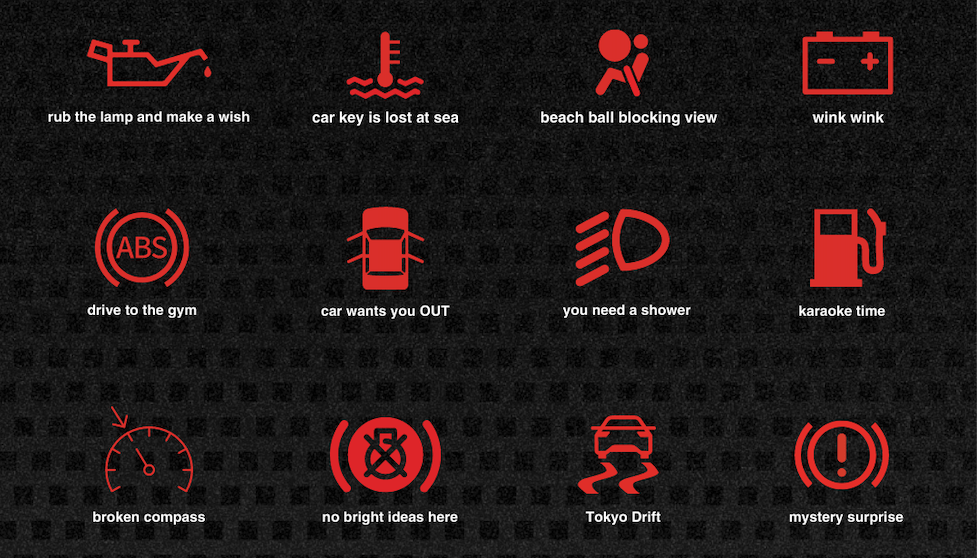Car Dashboard Lights: A Complete Guide to Car Warning Symbols
Key Takeaways
- Red lights = urgent. Stop safely and check immediately.
- Yellow lights = caution. Get your car inspected soon.
- Green or blue lights = normal operation. No action needed.
- Regular maintenance prevents most warning issues.
- Drive UAE offers resources to keep your car in top shape, from safety guides to maintenance support.
Have you ever noticed a strange light pop up on your car’s dashboard and wondered, “What does this mean?” Those small but important symbols are your car’s way of communicating with you, signaling everything from routine updates to urgent problems that need immediate attention. Ignoring them could lead to costly repairs, or even put your safety at risk.
Drive UAE will guide you about the most common car dashboard warning lights, explain what they mean, and help you understand how to respond effectively.
Categories of Dashboard Lights
Dashboard lights are divided into categories based on their urgency and the type of system they are monitoring.
Colors and Their Meanings
- Red: Signals immediate danger or a critical issue that requires immediate attention, such as engine problems or brake issues.
- Yellow/Amber: Indicates a warning or an issue that needs attention soon, like low tire pressure or oil levels.
- Green/Blue: Displays system information or confirms that a feature is active, such as cruise control or headlights.
Common Categories
- Engine and Mechanical Issues: Includes lights related to the engine, transmission, oil pressure, and temperature, warning of potential mechanical failures.
- Safety and Security Alerts: Covers warning lights for airbags, seat belts, or malfunctioning safety features to keep passengers secure.
- Electrical System Notifications: Indicates issues with the car’s battery, alternator, or power steering, which may affect the electrical system’s performance.
- Driver Assistance and Convenience: Lights related to features like lane-keeping assistance, parking sensors, and tire pressure monitoring to improve driving ease and safety.

Common Dashboard Warning Lights and Their Meanings
Dashboard warning lights are designed to alert you to issues with your car’s systems. Below are some of the most common warning lights and what they mean.

1. Check Engine Light
This light typically appears as an engine symbol. It can indicate a variety of issues, such as a faulty sensor, emissions problems, or engine misfires.

2. Oil Pressure Warning
This symbol looks like an oil can and warns you of low oil levels or poor oil pressure. Running your engine with low oil can lead to severe damage, so it’s important to stop and check your oil levels immediately.

3. Coolant Temperature Warning
This light, often resembling a thermometer submerged in liquid, indicates that your engine is overheating. This could be due to low coolant levels or a malfunction in the cooling system. Pull over and let the engine cool down before adding coolant or seeking assistance.

4. Brake Warning Light
The brake warning light can appear as a circle with an exclamation mark or the word “BRAKE.” It may mean that the parking brake is engaged or there’s an issue with the brake system, such as low brake fluid or worn-out brake pads. If this light stays on while driving, it’s crucial to get your brakes checked.

5. Tire Pressure Monitoring System (TPMS)
This symbol looks like a horseshoe with an exclamation mark in the middle. It indicates that one or more of your tires has low pressure. Driving with underinflated tires can cause poor fuel efficiency and increase the risk of tire damage, so it’s important to check your tire pressure promptly.

6. Battery Warning Light
The battery warning light looks like a battery symbol. It indicates a problem with the vehicle’s charging system, possibly related to the battery, alternator, or wiring. If this light comes on, your car may soon lose power, so it’s important to get it checked.

7. Anti-lock Braking System (ABS) Warning
This light appears as “ABS” or a circle with a “P” in the middle. It signals an issue with the anti-lock braking system, which helps maintain control during hard braking. While your regular brakes will still work, the ABS system may be disabled, so you should get it fixed soon.

8. Airbag Warning Light
The airbag warning light resembles a person sitting in a seat with a circle around them. It indicates a malfunction in the airbag system. If this light stays on, your airbags may not deploy in the event of an accident, which could be dangerous for you and your passengers.

9. Power Steering Warning Light
This symbol usually looks like a steering wheel with an exclamation mark. If it appears, there’s a problem with your car’s power steering system, which could make steering harder than usual. While you can still drive, it’s best to have the system checked before driving becomes more difficult.

10. Transmission Temperature Warning
This light appears when the transmission is overheating, often shown as a thermometer inside a gear symbol. Overheating can damage the transmission, so it’s important to stop and let the car cool down if you see this light.

What to Do When a Dashboard Light Appears
Here’s what you should do
- Stay Calm: Don’t panic; most lights signal minor issues or maintenance reminders.
- Identify the Light: Refer to your vehicle’s manual to understand the meaning of the warning light.
- Evaluate Urgency: Determine if the issue requires immediate attention (red light) or if it can wait (yellow/amber light).
- Take Action: Follow the recommended steps, such as checking fluid levels, tire pressure, or pulling over safely.
- Seek Professional Help: If the light indicates a serious issue or you’re unsure, contact a mechanic or roadside assistance.
Tips to Prevent Dashboard Warnings
Prevention is always better than repair. Simple habits can keep your dashboard warning-free:
- Get regular oil changes. Fresh oil keeps the engine cool and well-lubricated.
- Check tire pressure monthly. Under-inflated tires wear faster and affect fuel efficiency.
- Top up fluids. Keep brake fluid, coolant, and windshield washer fluid at proper levels.
- Inspect the battery. Corrosion and weak connections can trigger warning lights.
- Avoid running on low fuel. This strains the fuel pump and may trigger a warning.
- Service on time. Regular maintenance helps detect issues before they appear on the dashboard.
At Drive UAE, we encourage car owners to follow a consistent maintenance routine. A small service visit can save you from bigger problems later.
Why Understanding Dashboard Lights Matters in the UAE
Dubai, Abu Dhabi, and other emirates have long stretches of desert highways. Knowing what each dashboard light means isn’t just about convenience, it’s about safety and preparedness.
For example:
- Overheating is more common in hot weather.
- Tire pressure drops quickly in temperature changes.
- Sand and dust can clog sensors, triggering false warnings.
Being aware helps you act fast and avoid roadside emergencies, especially when driving long distances or at night.
When To Visit a Mechanic Immediately
Some warnings mean your car needs immediate attention. Visit a service center right away if you see:
- Red engine, oil, or brake warning lights.
- Flashing check engine light.
- Repeated warnings after restarting your car.
- Any unusual sound, smoke, or smell accompanying a dashboard alert.
- Delaying service might lead to costly repairs and safety risks.
Wrap Up
Dashboard warning lights are more than just symbols, they’re your car’s voice. Learning to recognize and respond to them keeps you, your passengers, and your vehicle safe on the road.
In the UAE’s demanding driving environment, staying informed and proactive can make a real difference. If you ever notice a warning light and aren’t sure what it means, don’t ignore it. A quick check with a trusted mechanic can prevent breakdowns and ensure your car runs smoothly.
At Drive UAE, we help you stay confident on the road with practical car care guides, expert tips, and trusted service recommendations. Because safe driving starts with knowing your vehicle.

